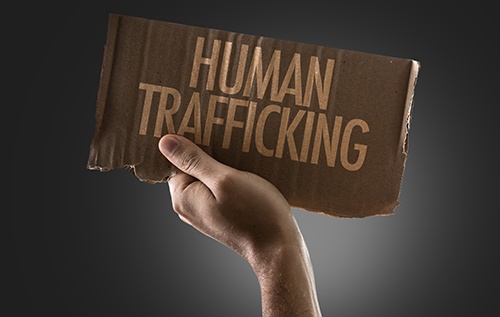
As the reality of human trafficking and modern slavery continues to make headlines around the world, automotive manufacturers and their supply chains are operating with heightened awareness. At AIAG’s 2017 Corporate Responsibility Summit, Michael R. Littenberg, partner in the securities and public companies practice group at Ropes & Gray, provided attendees with an overview of the challenges as well as updates on how governments and corporations are doing their part to combat the problem.
Helping automotive companies understand and navigate growing expectations from stakeholders on a broad range of corporate responsibility issues is the backbone of AIAG’s Corporate Responsibility Summit. The annual Summit helps AIAG members work collaboratively to improve global working conditions, reduce greenhouse gas emissions, and source materials throughout the supply chain in an ethically responsible manner.
Littenberg says global working condition challenges include slavery, servitude, forced or compulsory labor, and human trafficking, and these often co-exist with other poor labor practices. Slavery and servitude put an obligation on the victim to live on another’s property and deprives them of their freedom. Forced or compulsory labor is work or service extracted under threat of penalty or even threats of violence. Human trafficking is arranging or facilitating the travel of a person for the purpose of exploitation.
The U.S. and other countries have adopted corporate anti-human-trafficking legislations, such as the California Transparency in Supply Chains Act; U.S. Federal Acquisition Regulation Anti-Human Trafficking Rule; the U.K. Modern Slavery Act; and the French Corporate Duty of Vigilance Law. There are also numerous pending and proposed acts that will impact industries and corporations, such as the U.S. Business Supply Chain Transparency on Trafficking and Slavery Act, the Netherlands Child Labor Due Diligence Law, and the Australian Parliament’s adoption of national modern slavery legislation, as well as various industry codes of conduct, third-party standards, and recommendations. Corporations, therefore, must know what acts and codes exist in all the various parts of the world in which they do business.
Littenberg says that many of these acts require commercial organizations to prepare a slavery and human trafficking statement each year. “These statements must indicate the specific steps that your company has taken during that year to ensure human trafficking is not occurring in your supply chain or business,” he says. “That means you may be disclosing information about your organizational structure, supply chain relationships, policies, how you do your due diligence and auditing, how you train your people to recognize the signs of human trafficking and modern slavery, and how effective you’ve been in assessing and mitigating those risks.
“And stating that you aren’t doing anything is not an acceptable response,” he adds.
Developing a Compliance Plan
Littenberg says while the requirements of major acts will differ, a good compliance plan will include:
- An awareness program
- A process for employee reporting, including a hotline
- A recruitment and wage plan
- A housing plan if housing is provided
- Procedures to prevent agents and subcontractors from engaging in human trafficking
- Procedures to monitor, detect, and terminate agents or subcontractors that engage in prohibited activities
Further, if a compliance plan is required, then contractors should certify that they have implemented a compliance plan for themselves and their subcontractors and conduct due diligence to certify that none of their subcontractors or agents are involved in prohibited activities.
NGO Expectations
Littenberg says that a significant number of NGOs are focused on human trafficking across a broad range of products and geographies. Furthermore, NGO and other stakeholder engagement on this issue is becoming increasingly sophisticated.
“NGOs have an expansive view of modern slavery, so they expect corporations and industries to have robust policies and procedures,” says Littenberg. “They look for a good-faith risk assessment, due diligence in examining their supply chain, and meaningful efforts to mitigate risk.”
In addition, there are several lawsuits pending related to slavery and child labor in the supply chain that cite various theories for liability, he says. “Lawsuits alleging violations have been threatened by pension funds. In fact, NGOs have published guides on how to bring these claims. Expect enforcement of these acts and codes to become more rigorous.”
For companies looking to boost their compliance, Littenberg offers the following practical tips:
- Assess the applicability of various statutes and acts, and determine if you are meeting the statutory thresholds.
- Take a thoughtful, measured approach to assessing your human trafficking risk.
- Determine appropriate measures in light of perceived risks.
- Assess existing compliance policies and procedures, and implement any needed training.
- Leverage complementary supply chain compliance initiatives.
Finally, when assessing your level of risk, Littenberg says to take a look at the following:
- The origin of your raw materials
- Locations of manufacture and assembly
- The level of the use of subcontractors within your supply chain
- Use of temporary or seasonal labor
- Your vendors’ use of labor recruiters
- Level of supply chain pressures such as turnaround time
- Strength of local laws
He says vendor questionnaires and audits are important steps. He also suggests that attendees check U.S. Department of Labor’s List of Products Produced by Forced or Indentured Child Labor and List of Goods Produced by Child Labor or Forced Labor. The U.S State Department publishes country risk ratings, NGOs offer helpful resources, and industry associations also publish relevant reports.
“When adopting a new policy, don’t forget that you have an internal and an external audience,” he says. “Commit to engage with stakeholders and remedy anything that needs attention. And don’t forget to align policies with your CSR communications and implement a plan for ongoing monitoring.”
AIAG members can access all the presentations from this year’s Corporate Responsibility Summit online at www.aiag.org.
Carla Kalogeridis is AIAG’s e-news editor.


